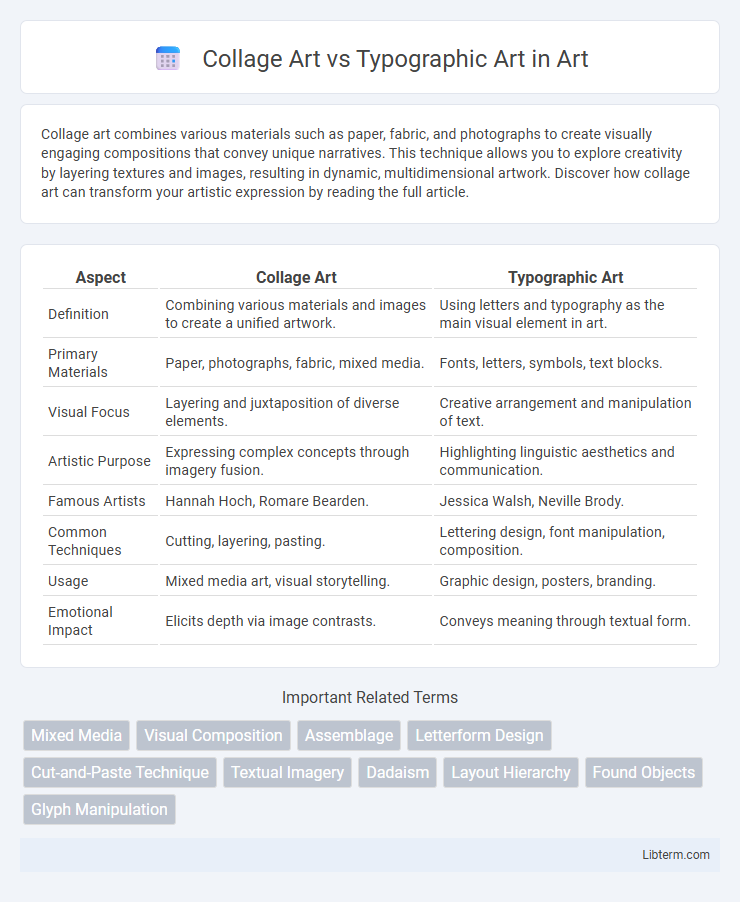Collage art combines various materials such as paper, fabric, and photographs to create visually engaging compositions that convey unique narratives. This technique allows you to explore creativity by layering textures and images, resulting in dynamic, multidimensional artwork. Discover how collage art can transform your artistic expression by reading the full article.
Table of Comparison
| Aspect | Collage Art | Typographic Art |
|---|---|---|
| Definition | Combining various materials and images to create a unified artwork. | Using letters and typography as the main visual element in art. |
| Primary Materials | Paper, photographs, fabric, mixed media. | Fonts, letters, symbols, text blocks. |
| Visual Focus | Layering and juxtaposition of diverse elements. | Creative arrangement and manipulation of text. |
| Artistic Purpose | Expressing complex concepts through imagery fusion. | Highlighting linguistic aesthetics and communication. |
| Famous Artists | Hannah Hoch, Romare Bearden. | Jessica Walsh, Neville Brody. |
| Common Techniques | Cutting, layering, pasting. | Lettering design, font manipulation, composition. |
| Usage | Mixed media art, visual storytelling. | Graphic design, posters, branding. |
| Emotional Impact | Elicits depth via image contrasts. | Conveys meaning through textual form. |
Introduction to Collage Art and Typographic Art
Collage art combines various materials such as paper, photographs, and fabric to create layered, textured compositions that emphasize visual storytelling and abstraction. Typographic art focuses on the creative arrangement of letters and fonts, transforming text into visually engaging designs that communicate meaning beyond words. Both forms leverage different elements of design--collage with material diversity and texture, typography with font style and layout--to convey artistic expression and narrative depth.
Historical Background of Collage Art
Collage art emerged in the early 20th century, pioneered by artists such as Pablo Picasso and Georges Braque during the Cubist movement, breaking traditional boundaries by assembling newspaper clippings, fabrics, and other materials onto canvas. This innovative technique challenged conventional forms of representation and enabled a new mode of expression that reflected modern life's fragmented nature. Collage art's historical roots highlight its role in revolutionizing visual art and influencing various styles, contrasting with typographic art's focus on letterforms and graphic design.
Evolution of Typographic Art
Typographic art has evolved from simple letterforms used in print media to complex digital compositions that blend typography with graphic design, reflecting advancements in technology and visual communication. Early typographic art relied heavily on manual typesetting and limited fonts, while contemporary typographic artists utilize software tools to manipulate typefaces in three-dimensional and interactive formats. This evolution highlights the shift from purely functional text to expressive, artistic representations that convey deeper meaning beyond words.
Key Techniques in Collage Art
Collage art relies on key techniques such as layering, cutting, and pasting diverse materials like paper, fabric, and photographs to create visually dynamic compositions. Artists employ assemblage, juxtaposition, and mixed media integration to evoke texture, depth, and narrative complexity. These methods distinguish collage art from typographic art, which primarily focuses on the arrangement and stylization of text elements for communication and aesthetic impact.
Essential Elements of Typographic Art
Typographic art centers on the strategic use of fonts, letterforms, and textual arrangement to convey meaning and evoke emotions, contrasting with collage art's reliance on layering diverse visual materials. Essential elements include font style, size, spacing, alignment, and color, which collectively enhance readability and aesthetic appeal while reinforcing the message. Mastery of typographic hierarchy and balance ensures that the text functions as both a communicative and artistic element, distinguishing this art form from the more eclectic and image-based nature of collage art.
Visual Impact: Comparing Collage and Typography
Collage art creates a dynamic visual impact by layering diverse materials and textures, resulting in rich, multidimensional compositions that engage viewers through contrast and complexity. Typographic art relies on the strategic use of fonts, sizes, and spacing to convey messages with clarity and stylistic expression, emphasizing form and readability. While collage captivates with its tactile and fragmented aesthetic, typography commands attention through precision and the deliberate arrangement of text elements.
Conceptual Differences in Artistic Expression
Collage art combines diverse materials and images to create a layered and tactile visual narrative, emphasizing texture, spatial relationships, and juxtaposition to evoke complex meanings. Typographic art relies on the arrangement and style of letters and fonts to communicate ideas, focusing on the visual impact of textual elements and their symbolic or linguistic significance. The conceptual difference lies in collage's sensory richness and materiality versus typographic art's reliance on language and typographic form to convey artistic expression.
Popular Artists in Collage and Typographic Art
Popular artists in collage art include Hannah Hoch, known for pioneering photomontage techniques, and Romare Bearden, celebrated for his vibrant narratives combining African American culture and abstract elements. In typographic art, notable figures like Jessica Walsh push creative boundaries by integrating custom lettering with dynamic visuals, while Stefan Sagmeister blends typography and design to evoke emotional responses. These artists exemplify how collage and typographic art uniquely manipulate imagery and text to communicate complex ideas.
Modern Trends in Collage and Typographic Art
Modern trends in collage art emphasize mixed media techniques, incorporating digital elements and layered textures to create dynamic compositions that challenge traditional boundaries. Typographic art has evolved with variable fonts and kinetic typography, blending expressive letterforms with motion graphics to enhance visual storytelling. Both art forms increasingly leverage technology and multimedia integration, reflecting contemporary preferences for interactive and immersive experiences.
Choosing Between Collage and Typography for Your Project
Choosing between collage art and typographic art depends on your project's goals and desired visual impact. Collage art offers a dynamic, textured aesthetic by combining diverse materials and imagery, ideal for storytelling and emotional expression. Typographic art emphasizes font styles, layout, and text-based design, making it perfect for conveying clear messages and branding with a strong visual hierarchy.
Collage Art Infographic

 libterm.com
libterm.com